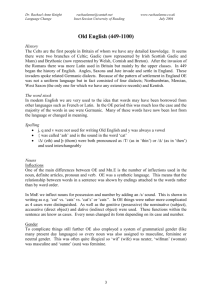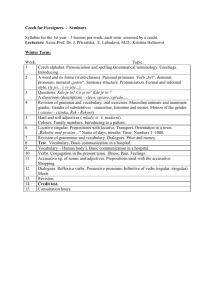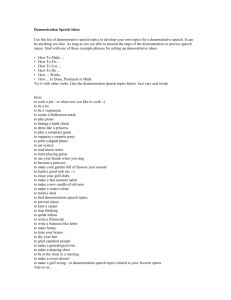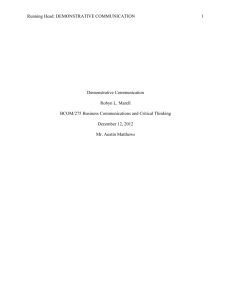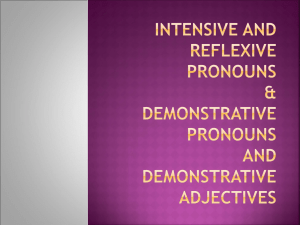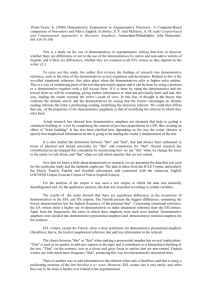1 Serbian Demonstrative Pronouns - Larisa Zlatic Language Services
advertisement
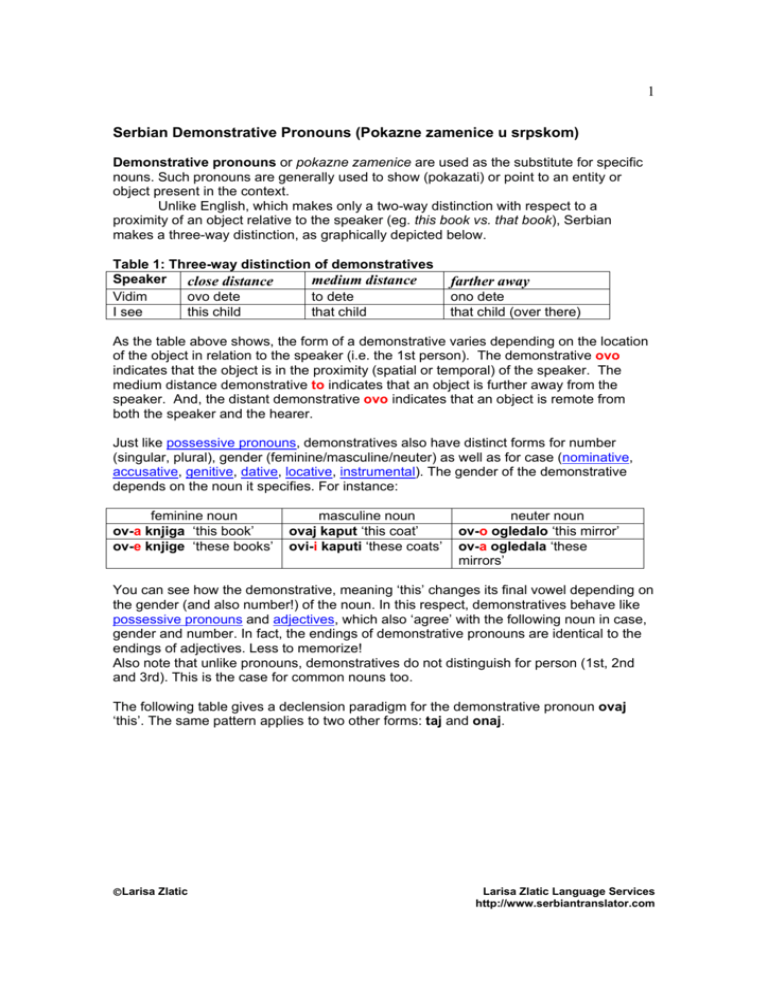
1 Serbian Demonstrative Pronouns (Pokazne zamenice u srpskom) Demonstrative pronouns or pokazne zamenice are used as the substitute for specific nouns. Such pronouns are generally used to show (pokazati) or point to an entity or object present in the context. Unlike English, which makes only a two-way distinction with respect to a proximity of an object relative to the speaker (eg. this book vs. that book), Serbian makes a three-way distinction, as graphically depicted below. Table 1: Three-way distinction of demonstratives Speaker medium distance close distance Vidim ovo dete to dete I see this child that child farther away ono dete that child (over there) As the table above shows, the form of a demonstrative varies depending on the location of the object in relation to the speaker (i.e. the 1st person). The demonstrative ovo indicates that the object is in the proximity (spatial or temporal) of the speaker. The medium distance demonstrative to indicates that an object is further away from the speaker. And, the distant demonstrative ovo indicates that an object is remote from both the speaker and the hearer. Just like possessive pronouns, demonstratives also have distinct forms for number (singular, plural), gender (feminine/masculine/neuter) as well as for case (nominative, accusative, genitive, dative, locative, instrumental). The gender of the demonstrative depends on the noun it specifies. For instance: feminine noun ov-a knjiga ‘this book’ ov-e knjige ‘these books’ masculine noun ovaj kaput ‘this coat’ ovi-i kaputi ‘these coats’ neuter noun ov-o ogledalo ‘this mirror’ ov-a ogledala ‘these mirrors’ You can see how the demonstrative, meaning ‘this’ changes its final vowel depending on the gender (and also number!) of the noun. In this respect, demonstratives behave like possessive pronouns and adjectives, which also ‘agree’ with the following noun in case, gender and number. In fact, the endings of demonstrative pronouns are identical to the endings of adjectives. Less to memorize! Also note that unlike pronouns, demonstratives do not distinguish for person (1st, 2nd and 3rd). This is the case for common nouns too. The following table gives a declension paradigm for the demonstrative pronoun ovaj ‘this’. The same pattern applies to two other forms: taj and onaj. Larisa Zlatic Larisa Zlatic Language Services http://www.serbiantranslator.com 2 Table 2: Declension of Serbian Demonstrative Pronouns SINGULAR masculine neuter feminine ovaj Nominative ovo ova ovo ovu ovaj/ovog* Accusative ovog ovog ove Genitive ovom ovom ovoj Dative ovom ovom ovoj Locative ovim ovom Instrumental ovim masculine neuter feminine PLURAL ovi ova ove Nominative ove ova ove Accusative ovih ovih ovih Genitive ovim ovim ovim Dative ovim ovim ovim Locative ovim ovim Instrumental ovim *In accusative singular, ovog is used when it refers to an animate object and ovaj is used for non-animate objects. Example: Vidim ovog čoveka “I see this man” vs. Vidim ovaj grad “I see this town” As the table above illustrates, for many cases, the demonstrative forms are identical: • In plural, the dative, locative and instrumental have the same forms. • Also in singular, dative and locative forms are identical. • In plural, gender is not distinguished for genitive, dative, locative and instrumental cases; the same forms apply to all three genders. Some examples are given in Table 3. The following abbreviations are used in Table 3: fem=feminine gender sing = singular acc= accusative masc=masculine pl = plural dat=dative gender neut=neuter gender nom = nominative gen= genitive inst=instrumental loc=locative Table 3: Some examples of demonstrative pronouns used in sentences English (the relevant Serbian Case, gender and number of pronoun is underlined) the demonstrative pronoun 1. Šta je to? What is that? to = nom. neut. sing. 2. Ovo dete je lepo. This child is beautiful. ovo = nom. neut. sing. 3. To je onaj čovek? That is that man. to = nom. neut. sing. onaj = nom. masc. sing. 4. Da li si video onoga? Did you see that (one)? onoga = acc. masc. sing. 5. On je video tog He saw that man. tog = acc. masc. sing. čoveka. 6. On se plaši ove* žene. He is afraid of this woman. ove = gen. fem. sing. 7. Mi se ne stidimo tih We’re not ashamed of tih = gen. masc. pl. studenata. those students. 8. Ja sam dao ovo onim I gave this (to) those ovo = acc. neut. sing. Larisa Zlatic Larisa Zlatic Language Services http://www.serbiantranslator.com 3 9. ljudima. One su na ovom stolu. people. Those were on this table. onim = dat. masc. pl. one = nom. fem. sing. ovom=loc. masc. sing. Exercise 1 – Fill out the appropriate case forms of demonstrative pronouns in sentences below Using the demonstratives below (underlined in the English gloss) insert their appropriate case forms. For convenience, I have indicated which case goes with which sentence. 1. genitive 4. dative 7. instrumental 2. genitive 5. accusative 8. genitive 3. accusative 6. nominative 9. accusative 1. Ja se bojim _______ 2. On se setio ______ 3. Marija voli ________ 4. Dragan je dao ružu ___________. 5. Da li si čula _______? 6. _______ je star. 6. Volim ____________. 7. Marija ide sa ______. 8. Zorica stalno sedi pored _______. 9. Milan stoji uz _________. I’m afraid of those snakes. He remembered this. Marija likes these songs. Dragan gave a rose to that girl. Did you hear that? This coat is old. I love that house. Marija is going with this boy. Zorica always sits by that window. Milan is standing by this house. Exercise 2 – Translate the following sentences For this exercise you need to know both the present tense and past tense. If you don’t have a bi-directional Serbian-English-Serbian dictionary, you may go to the website: http://www.krstarica.com/dictionary/ to get the words you need for this exercise. 1. He played with these students. 2. This lady doesn’t talk to me. 3. This summer we are going to Belgrade. 4. This tree is tall. 5. That man hates this neighbor. 6. His brother doesn’t like that girl. 7. That house is big. 8. We are singing with these people. Larisa Zlatic Larisa Zlatic Language Services http://www.serbiantranslator.com
